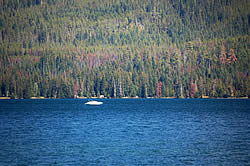Forests and Rangelands Success Story
D-Bug Hazard Reduction
Diamond Lake, Umpqua National Forest, Oregon
National Fire Plan - Fuels Reduction
2008

Trees near Diamond Lake suffering from recent bark beetle mortality.
On the Diamond Lake Ranger District of the Umpqua National Forest, the D-Bug Hazard Reduction project is entering its final stages of analysis using Healthy Forests Restoration Act (HFRA) authorities. The popular recreation area receives over 700,000 visitor days annually. Proposed treatment areas included federal land within Wildland Urban Interface areas around Diamond Lake Lodge, Lemolo Lake Lodge, Diamond Lake summer homes, several campgrounds, visitor use areas, and along the highways.
Much of the project area is dominated by lodgepole pine or contains a mix of pines, with other conifer species. An ongoing mountain pine beetle epidemic threatens all pine species in the area; local entomologists predict that up to 90% of mature lodgepole and other associated western white pine may die before the epidemic is over. These conditions will set the stage for a high risk of dangerous and uncontrollable wildfire that will threaten structures, improvements, and public safety.
The D-Bug Hazard Reduction project will address this epidemic in order to: reduce potential fuel loads, provide defensible space around structures and improvements, and treat roadside vegetation near evacuation routes. These treatments are also designed to serve as fuel breaks, providing firefighters valuable tactical options during a large fire event. Under direction of HFRA, the proposed action was developed collaboratively with numerous one-on-one discussions with interested groups and individuals, mailings to over 350 potentially interested people and groups, articles in local papers, and numerous public meetings and field trips. Planners integrated many comments before the formal scoping process required by the National Environmental Policy Act. Implementation could begin in 2008.
For more information, contact Joe Linn at 541-957-3204 or at jlinn@fs.fed.us.